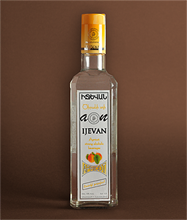I had never had a raw apricot (PLU #3302), so I snapped one up when they appeared at Whole Foods. My only previous exposure to apricot had been the bonbons in a box of Russel Stover chocolates. The first thing one notices about apricots is that they are like little jewels, with a dull orangeish-yellow glow like the setting sun. It's nice to hold this little fruit, roll it around in your hand, and look at it. The apricot is in the still-life hall of fame. Mine weighed 0.14 pound, so at $3.99/pound it cost 56 cents.
After washing your apricot, you can bite it like an apple, though the connoisseurs tend to break it or perhaps cut it in half along a seam. Apricot is a stone fruit like cherry, peach, or plum, so there is a stone in the center. Inside the stone (or pit) is the celebrated seed. (More on the seed later.) The seam in my apricot was not pronounced, so I had to cut mine in half with a knife. I ate everything except the stem and the stone. There was a taste, but it was so mild that it's hard to say anything about it. Some complain about the peel, but I found nothing distasteful or off-putting about it. The pit looks like a fat, unshelled almond. Here are my pictures.
- The whole apricot.
- The apricot cut in two.
- The pit, freshly harvested and still wet with apricot juice.
- The dried pit on the left, and for comparison an unshelled almond on the right.
The verdict: This small, firm fruit is pleasing to the touch and soothing to look at. The taste is inoffensive. In sum, the pleasure provided by this fruit is visual and tactile rather than gustatory.I am happy to say that you can get this pleasure in the store without buying the fruit. Since it is fairly cheap, however, you might want to bring one home so you can admire it, like Yorick's skull, while relaxing in your recliner.
An apricot tree is not usually grown from seed. Rather, as Wikipedia puts it:
Apricot cultivars are most often grafted onto plum or peach rootstocks. The scion from an existing apricot plant provides the fruit characteristics, such as flavour and size, but the rootstock provides the growth characteristics of the plant.
(Grafting terminology: The rootstock is the part of the plant with roots that grows from the ground. The rootstock, e.g., the plum is chosen because it grows well in the chosen habitat. The scion is the shoot from the desired plant, e.g., the apricot, that is affixed to the rootstock and whose production is desired. The general idea is that the rootstock and scion are both cut at an angle, and the vascular tissue of the scion is placed in contact with that of the rootstock, which then nourishes the scion and allows it to grow to maturity. It sounds like something out of a mad scientist movie, but it often works. To learn more about grafting generally, check out the link in the quotation above; to see details about grafting apricots specifically, see the video.) One reason why grafting is often used with apricot is that this tree is very particular about the soil that it will grow in, and grafting allows this constraint to be overcome. Keep in mind that for there to be a good chance for the graft to take, the rootstock and scion should be closely related. For example, apricots, plums, and peaches are closely related since they are all in the genusPrunus in the rose family.
Since the growth characteristics of the plant are determined by the rootstock rather than the apricot scion, one should not place undue emphasis on the shape of the apricot tree. Nevertheless, here are pictures of the apricot tree, fruit, and flowers.
A curiosity is that most almond extract comes not from almonds but from apricot or peach pits, which happen to contain bioidentical compounds. These substitutes are used since it is cheaper to to obtain this compound in this way. Also, this gives an added feeling of safety to sufferers of nut allergies. Almond extract is an ingredient in Gwen Robinson's cherry pie recipe, which is the recipe I have used for the last forty years. It is a coincidence that an apricot pit looks like an unshelled almond.
Apricots appear in a vast number of products, perhaps because apricot is the beige of fruits. I will cover the big three of fruit product areas, namely alcohol, beauty, and food.
As for alcoholic beverages. you might start with mixed drinks such as the apricot brandy slush or the apricot raspberry shrub pictured below. Next in the gallery of pictures comes the Mr. Boston apricot brandy. Pepe has the Mr. Boston book of mixed drinks, so he could doubtless use this book to prepare numerous delicious cocktails with this brandy, though perhaps the other apricot brandies would serve as well. Various liqueurs, ales, and ciders follow. (We have a curiosity that links Pepe and me--a Cuba apricot-flavored liqueur with vodka from Denmark; see Wine-Searcher for details.)








































